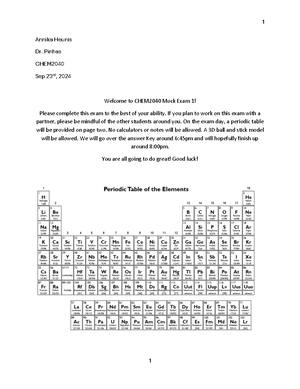- Information
- AI Chat
Was this document helpful?
Organic Chemistry Chapter 1 Part 2 Notes
Course: Organic Chemistry I (CHEM2040)
23 Documents
Students shared 23 documents in this course
University: University of Cincinnati
Was this document helpful?

Chapter 1 Notes Part II
Read Sec3ons 1.4 and 1.7 from your textbook and complete the following notes.
Isomers
What are isomers?
There are two classes of isomers we will discuss in our course. The first type that we will discuss for now are
cons3tu3onal isomers. Define this term. (What do they have that are the same and how do they differ?)
Cons*tu*onal isomers -
For now, we will focus on cons3tu3onal isomers. Draw the two different cons3tu3onal isomers for the molecular
formula C2H6O.
Now try again by drawing two cons3tu3onal isomers for C2H4Cl2.
One more 3me, draw three cons3tu3onal isomers with the formula C3H8O.
For molecular formulas containing rela3vely few atoms, drawing cons3tu3onal isomers can be preTy simple, but when
they get more complicated, it is helpful to use an addi3onal tool: Degrees of Unsatura*on.
What is a degree of unsatura*on?
A π bond (second bond of a double bond or second and third bonds of a triple bond) or a ring reduces the total number
of hydrogens in the formula by 2, so they have the same effect on the molecular formula (reduce it from being
“saturated” by the number of hydrogens it could hold).
Determine how many degrees of unsatura3on are in each of the following molecules:











